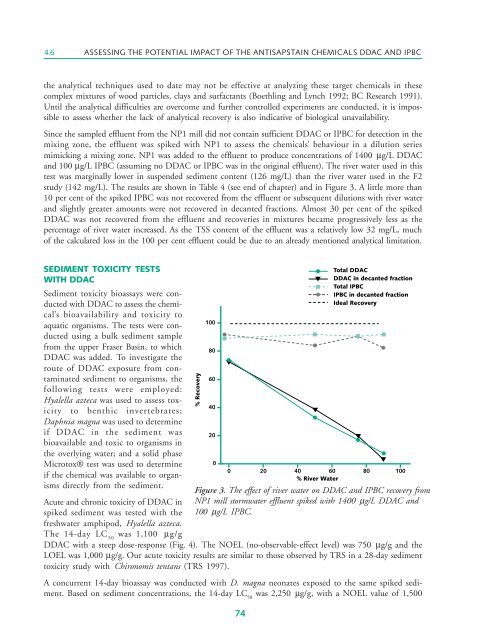assessing the potential impact of the antisapstain chemicals ddac ...
assessing the potential impact of the antisapstain chemicals ddac ...
assessing the potential impact of the antisapstain chemicals ddac ...
Create successful ePaper yourself
Turn your PDF publications into a flip-book with our unique Google optimized e-Paper software.
4.6 ASSESSING THE POTENTIAL IMPACT OF THE ANTISAPSTAIN CHEMICALS DDAC AND IPBC<br />
<strong>the</strong> analytical techniques used to date may not be effective at analyzing <strong>the</strong>se target <strong>chemicals</strong> in <strong>the</strong>se<br />
complex mixtures <strong>of</strong> wood particles, clays and surfactants (Boethling and Lynch 1992; BC Research 1991).<br />
Until <strong>the</strong> analytical difficulties are overcome and fur<strong>the</strong>r controlled experiments are conducted, it is impossible<br />
to assess whe<strong>the</strong>r <strong>the</strong> lack <strong>of</strong> analytical recovery is also indicative <strong>of</strong> biological unavailability.<br />
Since <strong>the</strong> sampled effluent from <strong>the</strong> NP1 mill did not contain sufficient DDAC or IPBC for detection in <strong>the</strong><br />
mixing zone, <strong>the</strong> effluent was spiked with NP1 to assess <strong>the</strong> <strong>chemicals</strong>’ behaviour in a dilution series<br />
mimicking a mixing zone. NP1 was added to <strong>the</strong> effluent to produce concentrations <strong>of</strong> 1400 μg/L DDAC<br />
and 100 μg/L IPBC (assuming no DDAC or IPBC was in <strong>the</strong> original effluent). The river water used in this<br />
test was marginally lower in suspended sediment content (126 mg/L) than <strong>the</strong> river water used in <strong>the</strong> F2<br />
study (142 mg/L). The results are shown in Table 4 (see end <strong>of</strong> chapter) and in Figure 3. A little more than<br />
10 per cent <strong>of</strong> <strong>the</strong> spiked IPBC was not recovered from <strong>the</strong> effluent or subsequent dilutions with river water<br />
and slightly greater amounts were not recovered in decanted fractions. Almost 30 per cent <strong>of</strong> <strong>the</strong> spiked<br />
DDAC was not recovered from <strong>the</strong> effluent and recoveries in mixtures became progressively less as <strong>the</strong><br />
percentage <strong>of</strong> river water increased. As <strong>the</strong> TSS content <strong>of</strong> <strong>the</strong> effluent was a relatively low 32 mg/L, much<br />
<strong>of</strong> <strong>the</strong> calculated loss in <strong>the</strong> 100 per cent effluent could be due to an already mentioned analytical limitation.<br />
SEDIMENT TOXICITY TESTS<br />
WITH DDAC<br />
Sediment toxicity bioassays were conducted<br />
with DDAC to assess <strong>the</strong> chemical’s<br />
bioavailability and toxicity to<br />
aquatic organisms. The tests were conducted<br />
using a bulk sediment sample<br />
from <strong>the</strong> upper Fraser Basin, to which<br />
DDAC was added. To investigate <strong>the</strong><br />
route <strong>of</strong> DDAC exposure from contaminated<br />
sediment to organisms, <strong>the</strong><br />
following tests were employed:<br />
Hyalella azteca was used to assess toxicity<br />
to benthic invertebrates;<br />
Daphnia magna was used to determine<br />
if DDAC in <strong>the</strong> sediment was<br />
bioavailable and toxic to organisms in<br />
<strong>the</strong> overlying water; and a solid phase<br />
Microtox® test was used to determine<br />
if <strong>the</strong> chemical was available to organisms<br />
directly from <strong>the</strong> sediment.<br />
Acute and chronic toxicity <strong>of</strong> DDAC in<br />
spiked sediment was tested with <strong>the</strong><br />
freshwater amphipod, Hyalella azteca.<br />
The 14-day LC 50 was 1,100 μg/g<br />
Figure 3. The effect <strong>of</strong> river water on DDAC and IPBC recovery from<br />
NP1 mill stormwater effluent spiked with 1400 μg/L DDAC and<br />
100 μg/L IPBC.<br />
DDAC with a steep dose-response (Fig. 4). The NOEL (no-observable-effect level) was 750 μg/g and <strong>the</strong><br />
LOEL was 1,000 μg/g. Our acute toxicity results are similar to those observed by TRS in a 28-day sediment<br />
toxicity study with Chironomis tentans (TRS 1997).<br />
A concurrent 14-day bioassay was conducted with D. magna neonates exposed to <strong>the</strong> same spiked sediment.<br />
Based on sediment concentrations, <strong>the</strong> 14-day LC 50 was 2,250 μg/g, with a NOEL value <strong>of</strong> 1,500<br />
74














